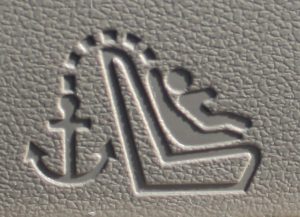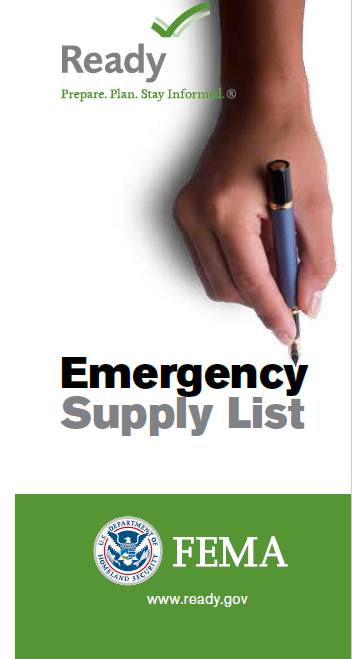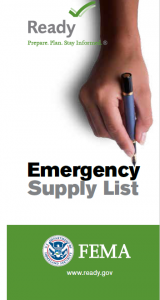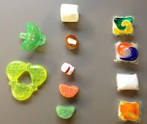
by Ginny Hinton | Apr 26, 2018
 As a child passenger safety technician/instructor for the past twenty years, I am always amazed at how quickly technology changes in the field. Both car seat and vehicle manufacturers are constantly testing innovations, making it difficult to know exactly how to properly use a car seat. One innovation that tends to give caregivers problems is the tether. Tethers are now a standard feature on every car seat and they are meant to be used with either the seatbelt or the LATCH (Lower Anchors and Tethers for Children) system. Tether anchors are required in passenger vehicles made after 2001.
As a child passenger safety technician/instructor for the past twenty years, I am always amazed at how quickly technology changes in the field. Both car seat and vehicle manufacturers are constantly testing innovations, making it difficult to know exactly how to properly use a car seat. One innovation that tends to give caregivers problems is the tether. Tethers are now a standard feature on every car seat and they are meant to be used with either the seatbelt or the LATCH (Lower Anchors and Tethers for Children) system. Tether anchors are required in passenger vehicles made after 2001.
For most car seats, tethers are not meant to be used rear-facing. A rear-facing seat is designed to dip and rebound in a frontal crash, cradling and protecting its young passenger. It doesn’t require a tether to do its job correctly. Forward-facing seats are a different story and tethers make them safer by allowing less head movement and stress on the spinal cord during a crash. Especially in a frontal crash, a tether can prevent serious head and neck injury by securing the top of the car seat and preventing several inches of forward head movement.
A tether is a strap of webbing with a hook at the end. Tethers connect the top of the car seat to the vehicle. They should be used for every forward-facing car seat installation, regardless of whether LATCH or a seatbelt is used to secure the seat itself. Most tethers need to be tightened only enough to remove slack. The manual that comes with each car seat offers important information on how to attach and tighten the tether properly.
If you have any questions about car seats, ask a certified child passenger safety technician in your area. You can find one near you at http://cert.safekids.org/
by Amy Mullins, PhD, RDN | Aug 24, 2017
 It’s something we all hopefully learned as children and carry with us now into adulthood: washing our hands often and properly. But I’m sorry to say that we’ve probably all witnessed numerous instances of people leaving the restroom, coughing or sneezing, touching their cell phones or any number of other filthy surfaces, and then neglecting to wash their hands. According to a research study from Michigan State University (2013), only 5% of people washed their hands properly after using the toilet with 7% of men and 15% of women not washing their hands at all. This type of behavior is a recipe for disaster, leading to the spread of germs and pathogens.
It’s something we all hopefully learned as children and carry with us now into adulthood: washing our hands often and properly. But I’m sorry to say that we’ve probably all witnessed numerous instances of people leaving the restroom, coughing or sneezing, touching their cell phones or any number of other filthy surfaces, and then neglecting to wash their hands. According to a research study from Michigan State University (2013), only 5% of people washed their hands properly after using the toilet with 7% of men and 15% of women not washing their hands at all. This type of behavior is a recipe for disaster, leading to the spread of germs and pathogens.
Germs and pathogens are invisible and ubiquitous, living on every imaginable surface. Even though they can’t be seen by the naked eye they have the ability to make us very sick, and can even be deadly. According to Dr. Charles Gerba, a microbiologist with the University of Arizona, a typical cell phone has approximately 25,000 germs per square inch! We spread germs very easily from surface to surface and from hand to mouth, increasing the potential for illness to ourselves and others every step of the way. If these germs contaminate food contact surfaces or the food we eat, the likelihood for a foodborne illness has been created. Common symptoms of foodborne illness include diarrhea, vomiting, nausea, and abdominal cramps. The Centers for Disease Control and Prevention (CDC) estimates that each year roughly 1 in 6 Americans (or 48 million people) gets sick, 128,000 are hospitalized, and 3,000 die of foodborne diseases.
The good news is that we all have the power to stop the spread of germs. The Food and Drug Administration says that “washing with plain soap and running water remains one of the most important steps consumers can take to avoid getting sick and to prevent spreading germs to others.”
It’s good practice to always wash your hands (CDC):
- Before, during, and after preparing food
- Before eating food
- Before and after caring for someone who is sick
- Before and after treating a cut or wound
- After using the toilet
- After changing diapers or cleaning up a child who has used the toilet
- After blowing your nose, coughing, or sneezing
- After touching an animal, animal feed, or animal waste
- After handling pet food or pet treats
- After touching garbage
Are you following these steps to proper handwashing (CDC)?
- Wet your hands with clean, running water (warm or cold), turn off the tap, and apply soap.
- Lather your hands by rubbing them together with the soap. Be sure to lather the backs of your hands, between your fingers, and under your nails.
- Scrub your hands for at least 20 seconds. Need a timer? Hum the “Happy Birthday” song from beginning to end twice.
- Rinse your hands well under clean, running water.
- Dry your hands using a clean towel or air dry them.
Soap and water may not always be available, so using hand sanitizer is the next best thing. Although hand sanitizers don’t kill all germs, the CDC recommends choosing a sanitizer with at least 60% alcohol to significantly reduce the number of germs and pathogens on your hands.
For more information on handwashing and hand sanitizers refer to the CDC Handwashing Factsheet. Additional information about foodborne illnesses and the pathogens that cause them can be found at https://www.cdc.gov/foodsafety/foodborne-germs.html

by Heidi Copeland | Aug 9, 2017
 Will you be ready if disaster strikes? Disasters, or devastating events-natural or human-generated, certainly can disrupt daily life. National Preparedness Month, held annually in September and sponsored by the Federal Emergency Management Agency (FEMA), is a good reminder that we need to be ready to respond to emergencies. Adversity can strike at any time. There is no time like the present to prepare for emergencies.
Will you be ready if disaster strikes? Disasters, or devastating events-natural or human-generated, certainly can disrupt daily life. National Preparedness Month, held annually in September and sponsored by the Federal Emergency Management Agency (FEMA), is a good reminder that we need to be ready to respond to emergencies. Adversity can strike at any time. There is no time like the present to prepare for emergencies.
How? Focus on making a standing plan for family readiness! A standing plan is one that you and your family have developed in the event of disasters. For most people, the prime goal is knowing that all family members are safe and as secure as possible against harm.
Need some help? Ready.gov has information to help you with that critical “what do we do in case of an emergency” conversation with children as well as seniors or any family member with special needs. The Ready.gov website contains a wealth of information to get you started including downloadable checklists and other publications as well as printable posters. Anyone can download the materials for free!
For instance, some disasters strike without warning. Have you thought about supplies you would need the most? Ready.gov supports the use of checklists as a good way to help you make it through an immediate disaster period.
Are you a pet owner? Ready.Gov has a unique brochure containing information for pet owners and suggestions for proactive pet emergency preparedness. Have you ever considered evacuating in the car with your animals?
Additionally, inadequate insurance coverage on a family home or properties can lead to major financial losses. NOW is the time to plan, document, and insure your property as well as prepare digital copies of your important financial information. One thing to keep in mind: FLOOD INSURANCE is a pre-disaster insurance protection program. Flood damage is not usually covered by typical homeowners insurance. Check your policy. Do not make assumptions.
Be smart; take part in preparing before an emergency happens!
- Implement a standing plan
- Prepare in ADVANCE
- Stay informed
You can plan ahead for an emergency. Take action now.
by jbreslawski | Jun 11, 2016
 In Florida, we are so lucky to have access to beautiful beaches and weather. There are an infinite number of outdoor activities to do. This past week I tried a new one for me, SUP (Stand Up Paddle boarding). I fell a few times, but finally found my balance and had a blast all day long. Things changed though when the fun was over and I realized that I forgot to wear a hat and had a blistering burn on my scalp. According to the Center for disease control the sun can burn unprotected skin in as little as 15 minutes. In order to protect yourself from the sun be sure to apply and reapply sunscreen (at least SPF 15) regularly, stay in the shade, wear a hat and UV protective sunglasses, when possible protective clothing such as long sleeved shirts and pants, and limit time outdoors in peak sun hours of 10am-4pm.
In Florida, we are so lucky to have access to beautiful beaches and weather. There are an infinite number of outdoor activities to do. This past week I tried a new one for me, SUP (Stand Up Paddle boarding). I fell a few times, but finally found my balance and had a blast all day long. Things changed though when the fun was over and I realized that I forgot to wear a hat and had a blistering burn on my scalp. According to the Center for disease control the sun can burn unprotected skin in as little as 15 minutes. In order to protect yourself from the sun be sure to apply and reapply sunscreen (at least SPF 15) regularly, stay in the shade, wear a hat and UV protective sunglasses, when possible protective clothing such as long sleeved shirts and pants, and limit time outdoors in peak sun hours of 10am-4pm.
Oh, so you don’t need to because you tan? Well think again. esides leaving you with an awful burn, blisters and flakey skin, sitting out in the sun can cause lines and wrinkles, sun-spots, and increase your chance of skin cancer. The American Cancer Society is estimating 6,200 new cases of skin cancer, this year, in Florida alone. Most of these cases can be linked to too much sun exposure. Regular sun protection can reduce the risk of developing skin cancer; regular dermatologist skin checks and self-exams can help identify cases early. The Skin Cancer Foundation, recommends keeping watch for individual moles that are misshapen, have uneven borders, a variety of colors, a diameter of over ¼”, or have changed in any of these features. This summer have fun, live in the moment, try something new, but don’t forget your SPF.

by Marie Arick | Aug 24, 2015
 Consumer Reports recently pulled their previous endorsement for laundry detergent pods in light of the potential poisoning hazard for young children. Just to be clear, this is only the laundry pods that contain the highly concentrated liquid detergent, not pods containing powdered detergent. Although these laundry pods are quickly accessed, pre-measured, use less packaging, and are just simple to use, they ultimately are not worth the lives of children. Ariana Eunjung Cha of The Washington Post recently highlighted this excerpt from Consumer Reports:
Consumer Reports recently pulled their previous endorsement for laundry detergent pods in light of the potential poisoning hazard for young children. Just to be clear, this is only the laundry pods that contain the highly concentrated liquid detergent, not pods containing powdered detergent. Although these laundry pods are quickly accessed, pre-measured, use less packaging, and are just simple to use, they ultimately are not worth the lives of children. Ariana Eunjung Cha of The Washington Post recently highlighted this excerpt from Consumer Reports:
‘When curious kids find their way into regular liquid laundry detergent, the result is often nothing worse than an upset stomach. Laundry detergent pods are presenting more serious symptoms. Along with vomiting, lethargy, and delirium, some victims have stopped breathing.’
Additionally, two children have died from ingesting a concentrated laundry detergent from a pod. Cha also noted “Last year, 11,714 reports of incidents involving kids aged 5 and younger and laundry detergent pods were reported to poison control centers nationwide. In the first six months of this year, there were more than 6,000.” This is a truly alarming fact that the numbers continue to rise. The Children’s Hospital Los Angeles posted this list on their blog:
Helpful Tips for Safety at Home
Tip 1: Cleaning materials should always be stored out of the reach of children and pets.
Tip 2: Install child-proof latches on under-sink cabinets in the kitchen and bathroom. Even if cleaning materials are no longer stored there, chemical smells may linger and could be dangerous to a child if they play under sinks.
Tip 3: Store laundry products on high shelves because many detergents can cause rashes or itching on a child’s sensitive skin.
Tip 4: Never leave a bottle or container of cleaning supplies open and unattended. Always close and put away the cleaning supplies if you are interrupted. You do not want any temptation sitting around that may harm your child.
Tip 5: When cleaning, take only the proper amount you need from the container, seal the container back up, and store the container away immediately. Use the proper equipment for handling the cleaning supply material, as recommended on the label. If the label says “Wear protective gear, gloves, or goggles,” do so to reduce harm to yourself and family.
Tip 6: When you are done cleaning, properly dispose of paper towels and rags that have come in contact with the cleaning chemicals.
Tip 7: Keep a list of emergency telephone numbers. Many cleaning products and chemicals have instructions on what to do if the product is used incorrectly, resulting in an emergency. Create and keep a first-aid kit that includes emergency-wash liquids. In the first-aid kid, keep a list of telephone numbers for:
- National Poison Control, 1-800-222-1222
- The nearest hospital
- A local ambulance service
- Your family doctor
The American Cleaning Institute urges consumers to “Pledge Now to be the KEY to a safe laundry room and routine!” Click here to take the pledge and for helpful tips for keeping your family safe.
Remember, treat all household cleaning items with care and always err on the side of caution. Look at the product you are purchasing and be aware of potential dangers. Review the warning labels and store in secured areas per label instructions. Always keep in mind: manufacturers use a product label to draw our attention to their product and this, however unintended, applies to children as well! Be diligent in keeping children safe. Personal convenience will never be more important than the life of a child.

 As a child passenger safety technician/instructor for the past twenty years, I am always amazed at how quickly technology changes in the field. Both car seat and vehicle manufacturers are constantly testing innovations, making it difficult to know exactly how to properly use a car seat. One innovation that tends to give caregivers problems is the tether. Tethers are now a standard feature on every car seat and they are meant to be used with either the seatbelt or the LATCH (Lower Anchors and Tethers for Children) system. Tether anchors are required in passenger vehicles made after 2001.
As a child passenger safety technician/instructor for the past twenty years, I am always amazed at how quickly technology changes in the field. Both car seat and vehicle manufacturers are constantly testing innovations, making it difficult to know exactly how to properly use a car seat. One innovation that tends to give caregivers problems is the tether. Tethers are now a standard feature on every car seat and they are meant to be used with either the seatbelt or the LATCH (Lower Anchors and Tethers for Children) system. Tether anchors are required in passenger vehicles made after 2001.




